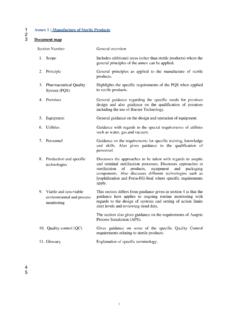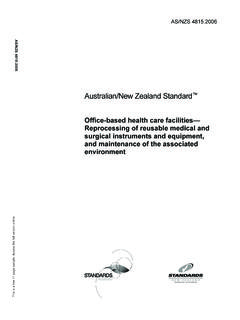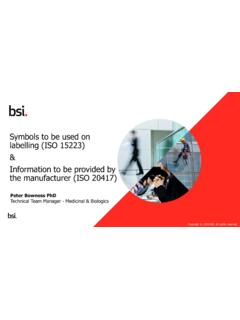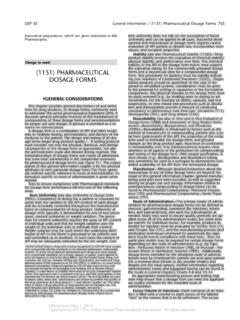Transcription of Draft guideline on the sterilisation of the medicinal ...
1 1 11 April 2016. 2 EMA/CHMP/CVMP/QWP/BWP/850374/2015. 3 Committee for medicinal Products for Human use (CHMP). 4 Committee for medicinal Products for Veterinary use (CVMP). 5 Quality Working Party (QWP). 6 Biologics Working Party (BWP). 7 guideline on the sterilisation of the medicinal product , 8 active substance, excipient and primary container 9 Draft Draft agreed by QWP and BWP December 2015. Adopted by CHMP for release for consultation January 2016. Adopted by CVMP for release for consultation February 2016. Start of public consultation 13 April 2016. End of consultation (deadline for comments) 13 October 2016. 10. 11 This guideline replaces Decision trees for the selection of sterilisation methods (CPMP/QWP/054/98), 12 the Annex to the note for guidance on development pharmaceutics (CPMP/QWP/155/96); and 13 The Annex Decision trees for the selection of sterilisation methods (EMEA/CVMP/065/99) to the note 14 for guidance: Development pharmaceutics for veterinary medicinal products (EMEA/CVMP/315/98).
2 15. Comments should be provided using this template. The completed comments form should be sent to 16. Keywords Active substance, Aseptic processing, Container, Decision trees, Excipients, Filtration, Finished Dosage form, sterilisation , sterilisation assurance level, Terminal sterilisation 30 Churchill Place Canary Wharf London E14 5EU United Kingdom Telephone +44 (0)20 3660 6000 Facsimile +44 (0)20 3660 5555. Send a question via our website An agency of the European Union European Medicines Agency, 2016. Reproduction is authorised provided the source is acknowledged. 17 guideline on sterilisation of the medicinal product , active 18 substance, excipient and primary container 19 Table of contents 20 Executive summary .. 3. 21 1. Introduction (background) .. 3. 22 2. 3. 23 3. Legal basis .. 4. 24 4. General requirements .. 4. 25 Manufacturing of sterile medicinal products .. 4. 26 Good manufacturing practice for sterile active substances and sterile 9.
3 27 Selection of sterilisation method .. 10. 28 5. Decision trees .. 11. 29 6. Definitions .. 13. 30 7. References .. 15. 31. guideline on sterilisation of the medicinal product , active substance, excipient and primary container EMA/CHMP/CVMP/QWP/BWP/850374/2015 Page 2/15. 32 Executive summary 33 This guideline provides guidance on the documentation expected for sterile products in the quality 34 dossier for a marketing authorisation application or a variation application for a medicinal product , 35 (called quality dossier throughout the guideline ), and the selection of appropriate methods of 36 sterilisation for sterile products. Although, terminal sterilisation using a reference condition of the 37 European Pharmacopoeia (Ph. Eur) is the method of choice whenever possible, this guideline provides 38 information on when other terminal sterilisation processes, sterilising filtration or aseptic processing, 39 (either alone or when combined with an additional terminal microbial reduction process), could be 40 accepted as an alternative to a reference terminal sterilisation process.
4 41 This guideline replaces the previous Annexes to Pharmaceutical development Decision trees for the 42 selection of sterilisation methods, (human and veterinary). In addition, the information on methods of 43 sterilisation previously described in Note for Guidance on manufacture of the finished dosage form 44 (human and veterinary) has been revised and included in this guideline . 45 1. Introduction (background). 46 Sterility is a critical quality attribute for all sterile products. Sterility of the medicinal product cannot be 47 assured by testing, it needs to be assured by the use of a suitable and validated manufacturing 48 process. Sterility is dependent on several factors such as the bioburden of the formulation 49 components, the sterilisation procedure, the integrity of the container closure system, (abbreviated as 50 container in this document), and in the case of aseptic processing, the use of satisfactory aseptic 51 technique.
5 Container integrity is discussed in ICH Q8, (formally adopted for human medicinal products 52 only, nevertheless the same principles are also applicable to veterinary medicinal products). 53 Terminal sterilisation is preferred to sterilisation by filtration and/or aseptic processing because it 54 provides a sterility assurance level (SAL) that is possible to calculate, validate and control, and thus 55 incorporates a safety margin. For aseptic processes, a SAL is not applicable as accidental 56 contamination caused by inadequate technique cannot be reliably eliminated by monitoring, control or 57 validation. Therefore, terminal sterilisation provides the highest assurance of sterility and should be 58 used whenever possible. For highly sensitive products such as biological products where terminal 59 sterilisation of the drug product is not possible, aseptic processing under controlled conditions provides 60 a satisfactory quality of the drug product .
6 61 In addition to those products where the formulation itself prohibits the possibility of terminal 62 sterilisation , the use of aseptic processing can be accepted in certain situations even if the formulation 63 itself can be terminally sterilised if other benefits are gained for the patients or users of the product . 64 These situations are specified below in section 65 2. Scope 66 The guideline applies to chemical and biological medicinal products for human and veterinary use, but 67 is not applicable for immunological veterinary medicinal products. 68 Guidance is provided on the choice of the method of sterilisation , the development and manufacturing 69 data required to support the manufacture of the finished product . The same principles, (choice of 70 method of sterilisation , development data and manufacturing), apply to sterile active substances, 71 excipients and primary containers. Only the information expected in a quality dossier, including 72 information on the need for Good Manufacturing Practice (GMP) certificates, is described.
7 General GMP. 73 requirements are not included. guideline on sterilisation of the medicinal product , active substance, excipient and primary container EMA/CHMP/CVMP/QWP/BWP/850374/2015 Page 3/15. 74 Terminal sterilisation by heat and ionising irradiation, using the reference conditions of Ph. Eur. 75 Methods of preparation of sterile products or other conditions to achieve a SAL of 10-6, sterilisation 76 by filtration and aseptic processing are considered. Terminal sterilisation by gas and its limitations is 77 also addressed. 78 The concepts in this guideline refer only to absence or removal of bacteria and fungi. The absence, 79 removal or inactivation of viruses, mycoplasma and other adventitious agents, which could 80 contaminate a product , are not considered. 81 3. Legal basis 82 This guideline should be read in conjunction with Directive 2001/83/EC on the community code relating 83 to medicinal products for human use Directive 2001/82/EC on medicinal products for veterinary use as 84 amended and also the current Ph.
8 Eur. 85 In addition, this guideline should be read in conjunction with all other relevant directives and 86 regulations, and all relevant Commission, (V)ICH and CXMP guidelines, Q&A documents and other 87 documents as linked to or published on the EMA website ( ). 88 4. General requirements 89 The guideline concerns only specific requirements relating to sterility and sterile products. For other 90 considerations on the manufacturing of the medicinal product , reference is made to other guidance 91 documents such as Guidelines on manufacture of the Finished Dosage Form. 92 Manufacturing of sterile medicinal products 93 Documentation regarding sterilisation and aseptic processing to be included in the quality dossier, 94 Module 3, sections Pharmaceutical development and manufacture for human products 95 or Part 2 Development pharmaceutics and Part 2 B Description of the manufacturing method for 96 veterinary products is presented below.
9 The documentation should be provided for all sites performing 97 sterilisation or aseptic processing related to the medicinal product , regardless of whether the processes 98 are performed in-house or outsourced. 99 The choice of method of sterilisation or aseptic processing should be justified, see section Selection 100 of sterilisation method. 101 All sterilisation processes should be carried out according to the instructions of the Ph. Eur. unless 102 justified. 103 All sterilisation procedures for the active substance, the excipient(s) or the primary containers should 104 be described and the name and address of the site responsible should be stated. Validation data should 105 be provided as described below for each sterilisation process. The required validation data for terminal 106 microbial reduction processes is the same as for the sterilisation processes, except for the 107 demonstration of a SAL of 10-6 or better.
10 108 When parametric release of sterility is proposed, the guideline on real time release testing (formerly 109 guideline on parametric release), EMA/CHMP/QWP/811210/2009-Rev1 (human products only), the 110 guideline on Parametric release, EMEA/CVMP/QWP/339588/2005 (veterinary products only) and the 111 text of Ph. Eur. Chapter should be taken into account. guideline on sterilisation of the medicinal product , active substance, excipient and primary container EMA/CHMP/CVMP/QWP/BWP/850374/2015 Page 4/15. 112 The levels of bioburden and bacterial endotoxins in the components (active substance, excipients and 113 primary package), as well as those introduced during manufacture and sterilisation can have an impact 114 on the level of bacterial endotoxins in the finished drug product . To ensure an acceptable level of 115 bacterial endotoxins in the finished drug product , the microbiological contamination of the components 116 should be minimal.
















